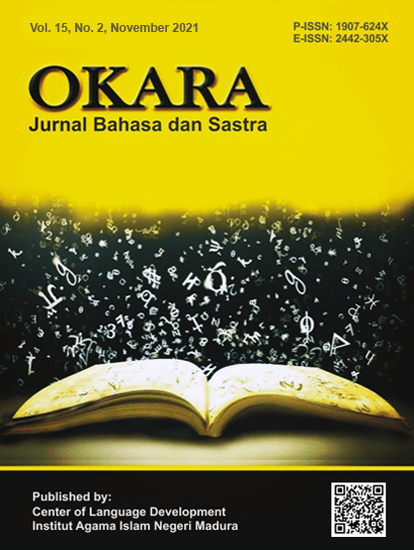Terror Narrative: Representing State Violence in Modern Indonesian Literature
 Abstract views: 512
,
Abstract views: 512
,
 PDF downloads: 595
PDF downloads: 595
Abstract
Literature and society are a way of looking at problems in society. Literature not only functions as entertainment, but it may also represent socio-political problems. Some literary works even carry more roles as both a reflection of such issues and a means of protest against them, including human rights violations. This paper examines how Indonesian literature has reflected human rights breaches, such as oppression in Indonesia during the New Order era. This qualitative research was conducted through direct documentation. The research revealed that the regime punished any individuals, groups, or institutions which tried to challenge its policy by the name of national stability. Some writers, such as Putu Wijaya, used anecdotes to protest against such oppression. He was a prolific Indonesian writer whose works often expose socio-political issues, such as human rights violations in Indonesia. His writings suggest his disagreement with such abuses. The three short stories investigated here "Sket," "Mulut," and "Rakyat" represent Putu Wijaya's dissent with the violence performed by the apparatus of the regime. Playing his role as a literary activist, Putu uses these stories to remind rights perpetrators that such cases as seen in the stories have taken place and might take place somewhere in Indonesia.
Downloads
References
Astuti, Tri Sakti Murti. “Aspek Sosial dalam Kumpulan Cerpen Protes Karya Putu Wijaya: Tinjauan Sosiologi Sastra.” Bachelor Thesis, Universitas Muhammadiyah Surakarta, 2010.
Chase, Cida S. “‘La Violencia’ and Political Violence in García Márquez’s Short Fiction.” The Journal of Popular Culture 22, no. 1 (1988): 73–82. https://doi.org/10.1111/j.0022-3840.1988.2201_73.x.
Collins, Elizabeth Fuller. “Indonesia: A Violent Culture?” Asian Survey 42, no. 4 (2002): 582–604. https://doi.org/10.1525/as.2002.42.4.582.
Dewanto, Nirwan. “Penutup.” In Kado Istimewa Cerpen Pilihan Kompas, edited by Kenedi Nurhan. Jakarta: Harian Kompas, 1992.
Ferdinal. “Censorship, Resistance and Transformation in Modern Indonesian Literature.” Mediterranean Journal of Social Sciences 4, no. 1 (2013): 269–72. https://doi.org/10.5901/mjss.2013.v4n1p269.
Ferdinal. “Injustice: Revealing Human Rights Issues in Ali Akbar Navis’s Short Fiction.” European Journal of Interdisciplinary Studies 1, no. 1 (2015): 137–43. https://doi.org/10.26417/ejis.v1i1.p137-143.
Ferdinal. “Women’s Rights and Colonization in the Short Story of The Jakarta Post.” Vivid: Journal of Language and Literature 9, no. 1 (2020): 1–11. https://doi.org/10.25077/vj.9.1.1-11.2020.
Fiddian, Robin. “Niall H. D. Geraghty, The Polyphonic Machine: Capitalism, Political Violence, and Resistance in Contemporary Argentine Literature.” Journal of Latin American Studies 52, no. 3 (2020): 673–75. https://doi.org/10.1017/S0022216X20000759.
Fletcher, Angus. Allegory: The Theory of Symbolic Mode. Ithaca and London: Cornell University Press, 1964.
Heriyati, Nungki, Riris K. Sarumpaet, and Christina T. Suprihatin. “Speaking Through Silence: Trauma in Literary Work.” In Proceedings of the International Conference on Business, Economics, Social Science, and Humanities – Humanities and Social Sciences Track (ICOBEST-HSS 2019). Bandung, Indonesia: Atlantis Press, 2020. https://doi.org/10.2991/assehr.k.200108.037.
Herlambang, Wijaya. Kekerasan Budaya Pasca 1965: Bagaimana Orde Baru Melegitimasi Anti-Komunisme Melalui Sastra dan Film. Tangerang: Marjin Kiri, 2013.
Heryanto, Ariel. Identitas dan Kenikmatan: Politik Budaya Layar Indonesia. 2nd ed. Jakarta: Kepustakaan Populer Gramedia, 2018.
Iyubenu, Edi AH. “Estetika Teror (Khas) Cerpen Koran.” Surabaya Post, June 12, 2000.
Logsdon, Martha Gay. “Neighborhood Organization in Jakarta.” Indonesia 18 (1974): 53–70. https://doi.org/10.2307/3350693.
Maier, Henk M. J. “Telling Tales, Cutting Throats the Guts of Putu Wijaya.” In Roots of Violence in Indonesia, edited by Freek Colombijn and J. Thomas Cinblad, 63–79. Leiden: KITLV Press, 2020.
Martin, Amy E. “The Dispossessed State: Narratives of Ownership in 19th Century Britain and Ireland; Human Encumbrances: Political Violence and the Great Irish Famine.” Nineteenth-Century Contexts 35, no. 4 (2013): 435–42. https://doi.org/10.1080/08905495.2013.822693.
Nurhadi. “Kekerasan di Indonesia dalam Karya Sastra.” Ibda’: Jurnal Kajian Islam dan Budaya, no. 55 (2009): 1–11.
Rafferty, Ellen. “The New Tradition of Putu Wijaya.” Indonesia 49 (1990): 103–16. https://doi.org/10.2307/3351055.
Ríos, Jerónimo. “Narratives about Political Violence and Reconciliation in Peru.” Latin American Perspectives 46, no. 5 (2019): 44–58. https://doi.org/10.1177/0094582X19856890.
Sunarti. “Nilai Nilai Budaya dalam Novel Tiba Tiba Malam Karya Putu Wijaya: Tinjauan Semiotik.” Bachelor Thesis, Universitas Muhammadiyah Surakarta, 2008. http://eprints.ums.ac.id/id/eprint/2357.
Wahyuni, Dessy. “Pertarungan Jurnalisme dan Sastra dalam Menguak Kebenaran.” Paradigma: Jurnal Kajian Budaya 9, no. 3 (2019): 231–55. https://doi.org/10.17510/paradigma.v9i3.325.
Wijaya, Putu. “Mulut.” Horison: Majalah Sastra, October 1995.
Wijaya, Putu. “Rakyat.” Horison: Majalah Sastra, October 1995.
Wijaya, Putu. “Sket.” In Kado Istimewa: Cerpen Pilihan Kompas 1992, edited by Kenedi Nurhan. Jakarta: Harian Kompas, 1992.
Žižek, Slavoj. Violence. New York: Picador, 2008.
The journal operates an Open Access policy under a Creative Commons Attribution-NonCommercial 4.0 International License. Authors who publish with this journal agree to the following terms:
- Authors retain copyright and grant the journal right of first publication with the work simultaneously licensed under a Creative Commons Attribution License that allows others to share the work with an acknowledgement of the work's authorship and initial publication in this journal.
- Authors are able to enter into separate, additional contractual arrangements for the non-exclusive distribution of the journal's published version of the work (e.g., post it to an institutional repository or publish it in a book), with an acknowledgement of its initial publication in this journal.
- Authors are permitted and encouraged to post their work online (e.g., in institutional repositories or on their website) prior to and during the submission process, as it can lead to productive exchanges, as well as earlier and greater citation of published work.





_(1).png)
.png)
.png)
1.png)
.png)
.png)

.png)
_-_Copy_-_Copy.png)





